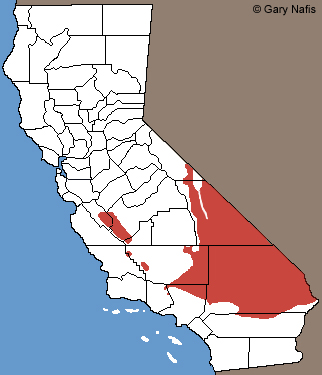|
 |
| Adult, Inyo County |
 |
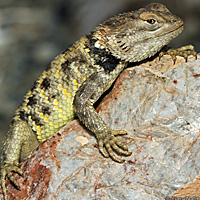 |
 |
 |
| |
Adult female, Inyo County |
|
 |
 |
 |
 |
| Adult female, Inyo County |
Adult male territorial display,
Inyo County |
Adult, Inyo County |
 |
 |
 |
 |
| |
Adult male, southern Inyo County |
|
 |
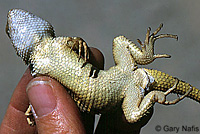 |
 |
 |
| Adult female, Inyo County |
Adult female, Inyo County |
Adult, Inyo County |
 |
 |
 |
 |
| Adult female, Inyo County |
Adult, Inyo County |
 |
 |
 |
 |
| Adult female, Inyo County |
Adult female, Inyo County |
Female from the Kingston Mountains, San Bernardino County. © Steve Bledsoe
|
Male from the Kingston Mountains, San Bernardino County. © Steve Bledsoe |
 |
 |
 |
 |
| Adult from the Coast Range near Coalinga, Kings County © Patrick Briggs |
Adult male throat © Patrick Briggs |
Adult male, Antelope Valley,
Kern County © Todd Battey |
 |
 |
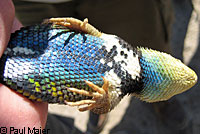 |
 |
| Adult male, Inyo County © Paul Maier |
Adult, Inyo County © Terry Goyan |
 |
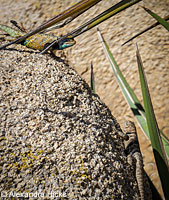 |
 |
 |
Adult male, San Bernardino County
© Alexandra Hicks |
Adult male (Top)
Adult female (Bottom)
San Bernardino County
© Alexandra Hicks
|
Adult male, Los Angeles County
© Todd Battey |
Adult male, Granite Mountains, San Bernardino County. © Keith Condon |
 |
 |
 |
 |
| Adult female, Kern County © Ryan Sikola |
Adult male, Mono County
© Keith Condon |
Adult female, Mono County
© Keith Condon |
 |
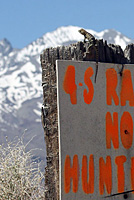 |
 |
 |
| When there's no rock or fence or tree to bask on, these lizards will climb up to the top of a bush to bask in the morning sun. |
Adult female, basking on sign post,
Inyo County |
Adult basking on brush, Inyo County |
Adult , Inyo County |
 |
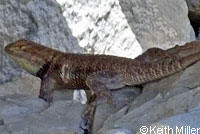 |
 |
 |
Adult male, San Bernardino County
© Jeff Ahrens |
Adult, San Luis Obispo County
© Keith Miller |
Adult, Inyo County |
Yellow-backed Spiny Lizards are covered with sharp-spined overlapping scales on much of the body. |
| |
|
|
|
| Large spiny lizards from the contact area between S. magister and S. uniformis |
 |
 |
 |
 |
| Adults, Morongo Valley, San Bernardino County © Bo Zaremba |
Adults, Morongo Valley, San Bernardino County © Bo Zaremba |
Adult, Northern Joshua Tree National Park, San Bernardino County
© Bo Zaremba |
Adult, Northern Joshua Tree National Park, San Bernardino County
© Bo Zaremba |
 |
|
|
|
Adult, Northern Joshua Tree National Park, San Bernardino County
© Bo Zaremba |
|
|
|
| |
|
|
|
| Yellow-backed Spiny Lizards From Outside California |
 |
 |
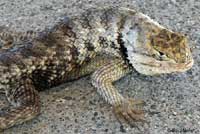 |
 |
Displaying adult male,
Washington County, Utah |
Adult male, Washoe County, Nevada
This large male spent the day laying around on the cement in the shade of the roof over the picnic table at my campsite, so I thought he was lazy and not hungry, but when I set a noosed juvenile Long-nosed Leopard Lizard about 12 feet from him to quickly get some photographs, he ran over and grabbed the little lizard, dragged it and the noose away, and shook the lizard back and forth trying to kill it (and probably eat it.)
But the lizard was still attached to the noose so I was able to grab the pole to rescue it and release it where it was found, shook up but still alive. |
 |
 |
 |
 |
| Adult female, Washoe County, Nevada |
Adult male, Washoe County, Nevada |
 |
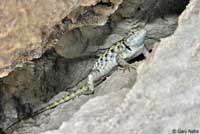 |
 |
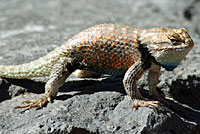 |
| Juvenile, Washoe County, Nevada |
Adult female, Washoe County, Nevada |
Adult female, Washoe County, Nevada |
Displaying adult male,
Washington County, Utah |
 |
 |
 |
|
| Adult, Humboldt County, Nevada © Spencer Riffle |
|
| |
|
|
|
| Juveniles |
 |
 |
|
|
| Juvenile, Nye County, Nevada |
Juvenile, Washoe County, Nevada |
|
|
| |
|
|
|
| Habitat |
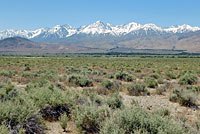 |
 |
 |
 |
| Habitat, Owens Valley, Inyo County |
Habitat, Inyo County |
Habitat, Inyo County |
Habitat, Inyo County |
 |
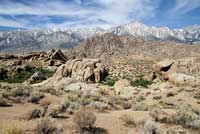 |
 |
 |
| Habitat, San Bernardino County |
Habitat, Inyo County |
Habitat, San Bernardino County |
Habitat, Panoche Hills, Coast Range,
San Benito County |
 |
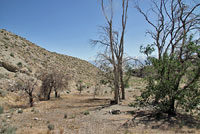 |
 |
 |
| Habitat, Kingston Mountains, San Bernardino County. © Steve Bledsoe |
Habitat, Inyo County |
Habitat, Inyo County |
Habitat, Inyo County |
| |
|
|
|
Short Videos
|
 |
 |
 |
|
| Yellow-backed Spiny Lizards pose and do territorial push-up displays in Southwest Utah. |
A big Yellow-backed Spiny Lizard is shown after being noosed, with the noose still around its neck. As soon as I begin to release it, hoping to get some more video of it on its tree, it fools me and runs away along the ground. |
Yellow-backed Spiny Lizards in the Nevada Desert |
|
|
|
|
|
| Description |
| |
| Size |
Adult males grow up to 5.5 inches long from snout to vent (SVL) (14 cm..)
Females grow up to 4.4 inches from snout to vent (1.12 cm).
The tail is slighly longer than the snout-to-vent length.
|
| Appearance |
| A robust, stout lizard with large pointed keeled scales |
| Color and Pattern |
Color is brown or tan with indistinct dorsal markings and a black wedge on the sides of the neck.
Markings may fade as the animal grows older.
Thin dark lines extend from the rear of the eye and mouth towards the posterior.
|
| Male / Female Differences |
Males have enlarged postanal scales and femoral pores, a swollen tail base, and a bluish patch on the throat and on the sides of the belly with black on the edges.
Females are pale in color underneath with faint or no blue markings.
The head of a female may be orange or reddish in the breeding season. |
| Young |
Juveniles lack the dark wedge markings on the neck and have dark and light spots on the back.
|
| Similar Species |
Sceloporus magister and Sceloporus uniformis were once considered the same species, and some herpetologists still consider this to be true.
The appearance of both species is so similar that it is difficult to tell them apart.
According to Jones, et al. in Lizards of the American Southwest, 2009
"Desert Spiny Lizards [S. magister] are somewhat larger, and adult males will have a black, deep purple, or red middorsal longitudinal stripe bordered by light stripes…."
S. uniformis "…tends to be yellow to tan above, without markings or with less distinctive markings than the Desert Spiny Lizard."
|
| Life History and Behavior |
Activity |
Diurnal.
Active generally from April through October, taking shelter during periods of excessive heat and cold.
A good climber, often seen on rocks, trees and walls, as well as on the ground.
Shelters under rocks, logs and other surface objects, and in cracks, burrows, and woodrat nests.
|
| Territoriality |
Males stand tall, extend the throat to expose the blue coloring, and push the body up and down to demonstrate their presence and command of the territory.
Short movie of push-up display. |
| Defense |
Very wary. Escapes by running away quickly into brush, rocks, or burrows.
The tail can break off easily, but it will grow back.
The detached tail wriggles on the ground which can distract a predator from the body of the lizard allowing it time to escape.
More information about tail loss and regeneration.
|
| Diet and Feeding |
Eats a variety of small invertebrates and their larvae including ants, beetles, grasshoppers, spiders, centipedes, and caterpillars, and occasionally small lizards, nestling birds, leaves, flowers and berries.
A sit-and-wait predator, though sometimes they will actively forage. |
| Reproduction |
Adults are sexually mature at 2 - 3 years.
Mating occurs in spring and early summer, generally May and June sometimes until August.
Females lay a clutch of 3 - 19 eggs between May and August.
During favorable years they may lay more than one clutch.
Young are typically seen in August and September, sometimes October.
|
| Habitat |
Inhabits desert flats, semiarid plains, low mountain slopes, riparian woods, including areas grown with, creosote bush, mesquite, yucca, Joshua trees, and grasses. Inhabits rock outcrops and rodent holes on the banks of dry stream beds in the Coast Range and Central Valley.
|
| Geographical Range |
In California, occurs mostly in the Mojave and Great Basin desert regions and along the western side of the Central Valley in the Coast Ranges from "the Panoche Hills to Buena Vista Hills." (Stebbins & McGinnis 2012)
The species ranges farther north and east into Nevada and extreme southwest Utah and northwest Arizona and just east of the Colorado River.
Determining the southernmost limit of the range of this species is not possible using the locality data of the specimens used in the Schulte, Macy, and Papenfuss 20061 study, or the 2007 Leache, Mulcahy study 2 because there are not enough samples in the entire area across San Bernardino County where S. uniformis meets S. magister. My range map may not be accurate in that area. Lizards in Cabazon group with S. magister, and a specimen from Riverside County in Joshua Tree National Park groups with S. magister, so I show the two species meeting near the junction of Riverside and San Bernardino Counties in that area based on the general description that S. uniformis is associated with the Mojave Desert and S. magister the Sonoran Desert. There maybe some overlap between the species, also.
|
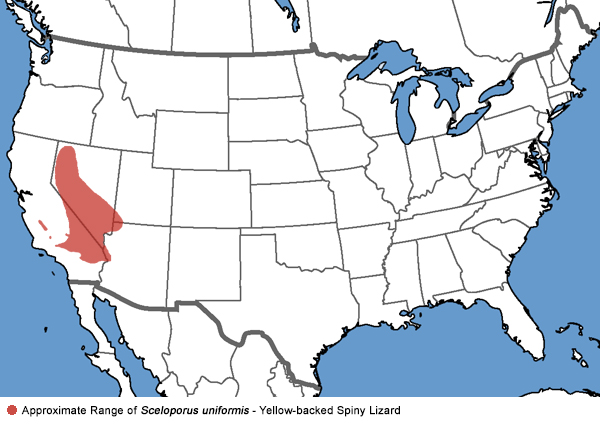 |
| Notes on Taxonomy |
Sceloporus magister taxonomy has been very confusing recently (as of May, 2009). As things stand, Sceloporus magister in California represents either one species, possibly with two subspecies, or two full species, the distribution of which does not follow the distribution of the long-accepted subspecies.
In 1996, Grismer & McGuire (1996 Herpetologica 52(3): 416-427) recommended that no subspecies of S. magister should be recognized.
1 In 2006, Schulte, Macey, and Papenfuss split S. magister into three species - S. magister, S. uniformis, and S. bimaculosus, with two subspecies of S. magister - S. m. magister, and S. m. cephaloflavus. However, their sample size was very small which makes it difficult to determine the ranges of these new species in California.
In 2008, the S.S.A.R., whose list this web site follows, adopted the 3 species taxonomy of Schulte et al in the sixth edition of their Scientific and Standard English Names of Amphibians and Reptiles of North America north of Mexico list.
The taxonomy used on this site now follows this re-organization:
S. m. uniformis - Yellow-backed Spiny Lizard and S. m. transversus - Barred Spiny Lizard, has been re-arranged into two species: S. magister - Desert Spiny Lizard, and S. uniformis - Yellow-backed Spiny Lizard.
(You can see a range map of the former species here.)
S. uniformis now contains the entire former S. m. transversus subspecies and part of the S. m. uniformis subspecies - those lizards from Coast Range and Central Valley regions and the Mojave Desert north into Nevada and the extreme southwest corner of Utah and the extreme northwestern corner of Arizona and two small areas near the Colorado River. The remaining former S. m. uniformis from the Sonoran desert in California east into Arizona and south into Baja California are now S. magister - Desert Spiny Lizard, the subspecies S. m. magister - Purple-backed Spiny Lizard. S. magister farther east in southern Utah, northern Arizona and the four corners area of Colorado and New Mexico are the subspecies S. m. cephaloflavus - Orange-headed Spiny Lizard. The subspecies S. m. bimaculosus - Twin-spotted Spiny Lizard has been elevated to full species - S. bimaculosus - Twin-spotted Spiny Lizard.
In 2007, Leache and Mulcahy concluded that "S. magister appears to represent a single geographically variable and widespread species." 2
In 2009, Collins & Taggart submitted the 2006 3 species proposal by Schulte, Macey, and Papenfuss to a lizard systematist group which disagreed, leaving them to continue to recognize one species - S. magister - Desert Spiny Lizard.
Alternate and Previous Names (Synonyms)
Sceloporus magister - Desert Spiny Lizard (no subspecies recognized) (Smith 1946)
Sceloporus magister - Desert Rough-scaled Lizard (Sceloporus clarkii; Sceloporus spinosus var. clarkii; Sceloporus orcutti, part. Scaly Lizard; Clark's Alligator Lizard; Fence Lizard, part; Clark's Lizard; Great Fence Lizard) (Grinnell and Camp 1917)
|
| Conservation Issues (Conservation Status) |
| None |
|
|
Taxonomy |
| Family |
Phrynosomatidae |
Zebra-tailed, Earless, Fringe-toed, Spiny, Tree, Side-blotched, and Horned Lizards |
Fitzinger, 1843 |
| Genus |
Sceloporus |
Spiny Lizards |
Wiegmann, 1828 |
Species
|
uniformis |
Yellow-backed Spiny Lizard |
Phelan and Brattstrom, 1955 |
|
Original Description |
Sceloporus uniformis - Phelan and Brattstrom, 1955 - Herpetologica, Vol. 11, p. 10
from Original Description Citations for the Reptiles and Amphibians of North America © Ellin Beltz
|
|
Meaning of the Scientific Name |
Sceloporus - Greek -skelos leg and porus - pore or opening - refers to the femoral pores on hind legs
uniformis - Latin - uni - one and formis - shape - refers to the lack of pattern on the dorsum
from Scientific and Common Names of the Reptiles and Amphibians of North America - Explained © Ellin Beltz
|
|
Related or Similar Neighboring California Lizards |
Sceloporus magister - Desert Spiny Lizard
Sceloporus occidentalis longipes - Great Basin Fence Lizard
Sceloporus graciosus graciosus - Northern Sagebrush Lizard
|
|
More Information and References |
California Department of Fish and Wildlife
Stebbins, Robert C., and McGinnis, Samuel M. Field Guide to Amphibians and Reptiles of California: Revised Edition (California Natural History Guides) University of California Press, 2012.
Stebbins, Robert C. California Amphibians and Reptiles. The University of California Press, 1972.
Flaxington, William C. Amphibians and Reptiles of California: Field Observations, Distribution, and Natural History. Fieldnotes Press, Anaheim, California, 2021.
Samuel M. McGinnis and Robert C. Stebbins. Peterson Field Guide to Western Reptiles & Amphibians. 4th Edition. Houghton Mifflin Harcourt Publishing Company, 2018.
Stebbins, Robert C. A Field Guide to Western Reptiles and Amphibians. 3rd Edition. Houghton Mifflin Company, 2003.
Behler, John L., and F. Wayne King. The Audubon Society Field Guide to North American Reptiles and Amphibians. Alfred A. Knopf, 1992.
Powell, Robert., Joseph T. Collins, and Errol D. Hooper Jr. A Key to Amphibians and Reptiles of the Continental United States and Canada. The University Press of Kansas, 1998.
Bartlett, R. D. & Patricia P. Bartlett. Guide and Reference to the Turtles and Lizards of Western North America (North of Mexico) and Hawaii. University Press of Florida, 2009.
Jones, Lawrence, Rob Lovich, editors. Lizards of the American Southwest: A Photographic Field Guide. Rio Nuevo Publishers, 2009.
Smith, Hobart M. Handbook of Lizards, Lizards of the United States and of Canada. Cornell University Press, 1946.
Macey, J. Robert and Theodore Papenfuss."Herpetology." The Natural History of the White-Inyo Range Eastern California. Ed. Clarence Hall. University of California Press, 1991.
1 A genetic perspective on the geographic association of taxa among arid North American lizards of the Sceloporus magister complex (Squamata: Iguanidae: Phrynosomatinae)
James A. Schulte II, J. Robert Macey & Theodore J. Papenfuss 2006.
Molecular Phylogenetics and Evolution 39: 873-880
2 Phylogeny, divergence times and species limits of spiny lizards (Sceloporus magister species group) in western North American deserts and Baja California
ADAM D. LEACHE and DANIEL G. MULCAHY
Molecular Ecology (2007) doi: 10.1111/j.1365-294X.2007.03556.
Joseph Grinnell and Charles Lewis Camp. A Distributional List of the Amphibians and Reptiles of California. University of California Publications in Zoology Vol. 17, No. 10, pp. 127-208. July 11, 1917.
|
|
|
The following conservation status listings for this animal are taken from the January 2024 State of California Special Animals List and the January 2024 Federally Listed Endangered and Threatened Animals of California list (unless indicated otherwise below.) Both lists are produced by multiple agencies every year, and sometimes more than once per year, so the conservation status listing information found below might not be from the most recent lists. To make sure you are seeing the most recent listings, go to this California Department of Fish and Wildlife web page where you can search for and download both lists:
https://www.wildlife.ca.gov/Data/CNDDB/Plants-and-Animals.
A detailed explanation of the meaning of the status listing symbols can be found at the beginning of the two lists. For quick reference, I have included them on my Special Status Information page.
If no status is listed here, the animal is not included on either list. This most likely indicates that there are no serious conservation concerns for the animal. To find out more about an animal's status you can also go to the NatureServe and IUCN websites to check their rankings.
This animal is not included on the Special Animals List, which indicates that there are no significant conservation concerns for it in California.
|
| Organization |
Status Listing |
Notes |
| NatureServe Global Ranking |
|
|
| NatureServe State Ranking |
|
|
| U.S. Endangered Species Act (ESA) |
None |
|
| California Endangered Species Act (CESA) |
None |
|
| California Department of Fish and Wildlife |
None |
|
| Bureau of Land Management |
None |
|
| USDA Forest Service |
None |
|
| IUCN |
|
|
|
|
